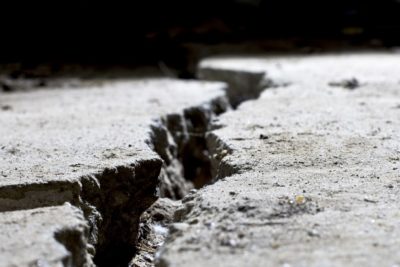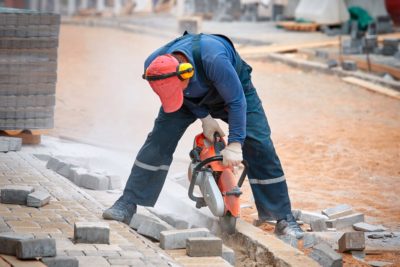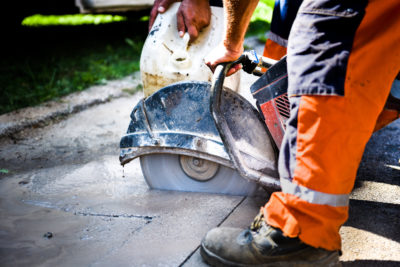Polished concrete is a modern flooring option that offers commercial spaces an endless list of benefits beyond its sleek appearance. With an impressive list of advantages that include long-lasting durability that rivals floorboards and carpets, it’s not surprising that Retail spaces, Hospitals, Commercial Warehouses and Office Buildings are utilising this smooth, trendy and long-lasting option. But, how to polish concrete? Let’s first start with the basics.
What is concrete polishing?
Concrete floor polishing is a process that involves using specific concrete grinding equipment, to grind concrete surfaces and create a smooth high-quality finish.
There are different methods and finishes to choose from depending on the look you or your client prefers. From a high-gloss minimal appearance to a speckled matte look that includes exposing lots of the aggregate in the concrete slab.
Different methods: Grind and seal and Mechanically Polished Concrete
Different finishes: Matte, Semi-gloss and High-gloss.
Aggregate/Stone Exposure: None, Minimal exposure, Full exposure.
Where is polished concrete used (most suitable applications)
Polished concrete has a hard-wearing and long-lasting appeal that is perfect for high-traffic commercial spaces. From being resistant to chemical spills and dust build-up to lightening up dark spaces and withstanding heavy industrial equipment, there are many reasons why concrete polishing is the perfect choice for Commercial spaces.
Commercial spaces that benefit from polished concrete floors:
- Retail Stores
- Hair and nail Salons
- Restaurants
- Warehouses
- Offices
- Hospitals
- Showrooms.
Pros and cons of polished concrete
PROS:
Durable:
Polished concrete flooring is perfect for Warehouses and any commercial space because it is hard-wearing and incredibly durable. Despite the high-foot traffic and use of heavy equipment in commercial spaces polished concrete will remain in good condition.
Affordable:
Considering that the cost of good quality flooring is similar across all different materials, from polished concrete to hardwood floorboards to wool carpet, the long-lasting, low maintenance, durability of concrete means it is an affordable option. Especially when comparing how often floorboards and carpet need to be replaced to maintain quality and appearance.
Long-lasting:
Compared to carpet and hardwood flooring, polished concrete is expected to easily last over 100 years despite being in a high-traffic commercial space.
Environmentally friendly:
Polished concrete floors are not coated with toxic chemicals and do not contain VOC – harmful Volatile Organic Compounds compared to synthetic flooring.
Low-maintenance
Dirt and dust don’t show up as easily on Polished concrete floors making them very easy to clean and perfect for busy commercial spaces. They also don’t require frequent replacing or stripping and staining to maintain a high-quality appearance.
Reflective
To bring more light into a dark commercial space high-gloss polished concrete floors will provide a perfect energy-efficient solution.
Customisable
There are endless options available when it comes to choosing different levels of gloss, texture, and colours.
CONS:
Hard
Due to the benefit of long-lasting strength and durability polished concrete flooring is extremely hard, resulting in it also being an uncomfortable floor to stand on for long periods of time.
Cold
Similar to tiles polished concrete floors do not retain heat very well in cold weather. This is mostly an issue in domestic spaces, compared to commercial, and this can be overcome with underfloor heating.
Loud
Sound bounces off polished concrete, tiles and natural stone flooring more easily than softer flooring materials. If this is an issue for a commercial space it is fixed by filling the area with lots of rugs and heavy drapes to absorb the sound.
Tips for perfect polished concrete floors
Choose the right design for your commercial space
Once the concrete floor polishing process is complete you will be stuck with it for a long time. So you want to make sure you, or your client, are happy with the type of concrete colour, texture and finish chosen before the polishing process begins.
Utilise concrete cutting to minimise cracks:
After spending a long time grinding the surface of your concrete slab the last thing you want are cracks occurring and altering the appearance of your perfect polished concrete flooring. Concrete cutting is a great tool for controlling cracks and hiding them within clean lines. Any concrete cutting should be made before the grinding process begins to avoid deterioration.
Don’t forget Concrete curing:
Curing concrete is the long and crucial hydration process of preventing water evaporating and warmth from escaping from your concrete slab during its drying, and strengthening, period.
When concrete curing is done properly your concrete slab will be more durable, strong, and resistant to harsh conditions.
Hire skilled contractors:
For the best results hire expert contractors, over general contractors. Specialised tradesmen will understand the fragile process of polishing concrete and will be able to deliver high-quality results for you or your client.
Approve a sample before you begin:
Polished concrete floors are made up of cement and water and aggregate. The type and size of the aggregates used in the mix will greatly affect the appearance of your polished concrete floor. We recommend approving a sample before beginning to avoid any costly mistakes.
Don’t skip through the preparation and planning stage:
Correctly preparing your site, completing necessary and planning your concrete floor polishing process before you begin will prevent costly mistakes during this long and time-sensitive undertaking. Such as avoidable variations in colour and cracks in the surface of your concrete slab.
Use Densifiers and sealers constantly throughout the concrete grinding process:
You should always use densifiers and sealers when polishing concrete. Densifiers should be used first, this is a liquid silicate hardener that hardens the concrete slab and fills in any holes. A sealer is applied at the end, this will enhance the colour and sheen of your concrete slab and protect the surface from stains and scratches.
Concrete floor polishing involves a long and fragile process that requires specific equipment, such as concrete floor grinders and a concrete cutting saw, and expert knowledge, but its sleek and highly durable appearance makes it well worth the time and effort.
Diamond Cut Concrete are trusted professionals with years of experience delivering high-quality and efficient polished concrete expertise and concrete cutting in Perth. Contact us today for a quote.



